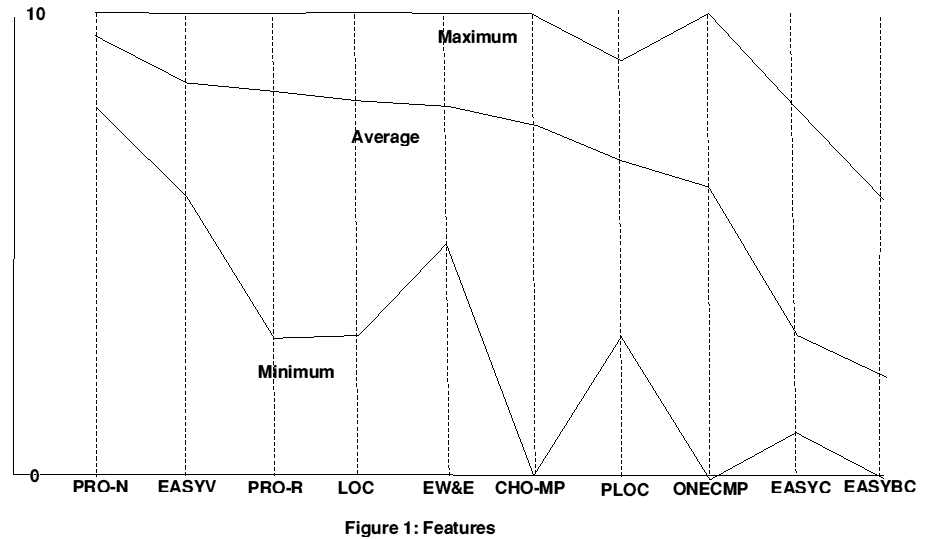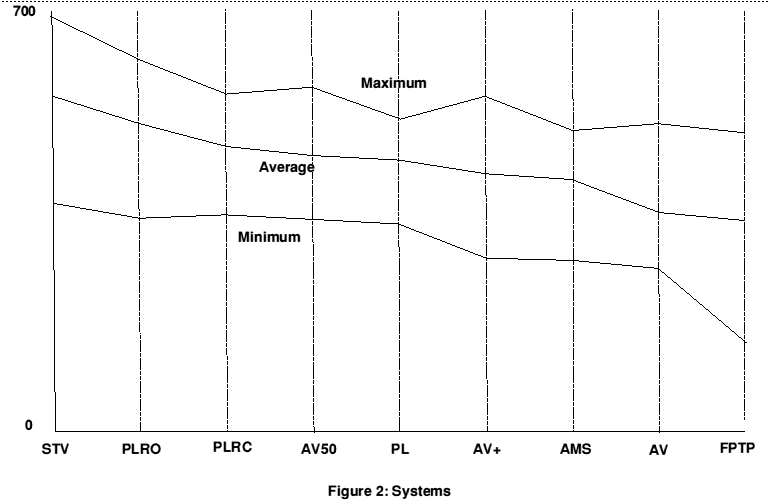Up: Issue 14
Previous: Paper 3
Voting matters - Issue 14, December 2001
Decision Analysis - Responses to a Questionnaire
H G Jones
Bob Jones is a retired mathematician and former secretary of Derbyshire Electoral Reform Group (DERG).
Introduction
An article describing the application of Decision Analysis to choice of
`best' electoral system was given in Issue 12 of Voting matters.
Readers were invited to complete their own version of the Analysis Table
supplied. The present article gives an analysis of the responses received.
Not surprisingly, in view of the readership of Voting matters nearly
all favoured STV. It was therefore decided to invite a wider population to
respond. This was just before the General Election on June 7th and
candidates from the local `Jenkins AV+' area were contacted. The area
consists of the present constituencies of Cheltenham, Gloucester,
Tewkesbury, Stroud, Cotswold, and Forest of Dean. Responses from some 20
candidates was sparse so other political and non-political people were
contacted.
A total of 14 responses was received.
Method of averaging
For each FEATURE (of a voting system) the average value from respondents was
evaluated. These features are plotted in Figure 1 in the order giving the
most liked feature first. In that order, the features are:
- PRO-N: How proportional is the national result?
- EASYV: How easy is the system for the voter to use?
- PRO-R: How proportional is the result within a region? (A region is
visualised as, say, 10 of the present neighbouring constituencies.)
- LOC: Local link - How closely are MPs linked to an area?
- EW&E: Does the system encourage women and people from ethnic minorities
to stand for election?
- CHO-MP: Is there a choice within a party as well as across party lines?
- PLOC: How easily can constituents contact an MP of their preferred
political persuasion?
- ONECMP: Is there one class of MP? (Some systems have regional as well
as local MPs)
- EASYC: How easy is the process of counting?
- EASYBC: How easy is the task of the Boundary Commission?
- STAB: Stability of government. STAB really asks the question `Is the
government likely to complete its normal period of office?' Critics of PR
sometimes say it results in `weak' coalition government. This has some
validity with Party Lists, particularly when based on the whole country as
in Israel. Experience in Germany since 1945 with AMS, and in Eire since 1922
with STV are to the contrary.

It should be noted that the Voting matters article used a range of
weighing factors from 0 to 3, whereas from March 2001 a range from 0 to 10
was in use. Furthermore the additional FEATURE of STAB was not considered as
it did not appear in the original Voting matters article.
For each voting system, a similar plot is produced in Figure 2. Here the
systems in reducing order of preference are:
- STV: Single Transferable vote.
- PLRO: Party List based upon a region and using open lists.
- PLRC: Party List based upon a region and using closed lists.
- AV50: Similar to AV+, but having a 50% top-up element.
- PL: Party List.
- AV+: The proposal made by Lord Jenkins.
- AMS: Additional Member System as used in Germany since 1945 and in
differing forms for the Scottish Parliament and the Welsh Assembly.
- AV: Alternative vote.
- FPTP: First Past the Post (as used in Westminster).

Readers who would like to fill in their own questionnaire can obtain a
copy from the Editor by writing to ERS or electronically by e-mailing
Brian.Wichmann@freenet.co.uk.
Up: Issue 14
Previous: Paper 3